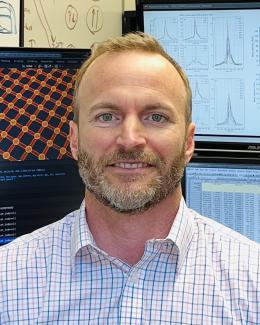Abstract
Ion implantation has been widely used in the semiconductor industry for decades to selectively control electron/hole doping for device applications. Recently, experimental studies on ion implantation into more structurally and electronically complex materials have been undertaken in which defect generation has been used to control a variety of functional phenomena. Of particular interest, are recent findings demonstrating that low doses of low energy helium ions into single crystal films can be used to tailor the structural properties. These initial experimental studies have shown that crystal symmetry can be continuously controlled by applying increasingly large doses of He ions into a crystal. The observed changes in lattice structure were then observed to correlate with functional changes, such as metal-insulator transition temperature2 and optical bandgap3. In these preliminary experimental studies, changes to lattice expansion was proposed to be the direct result of chemical pressure originating predominantly from the implanted He applying chemical pressure at interstitial sites. However, the influence of possible secondary knock-on damage arising from the He atoms transferring energy to the lattice through nuclear-nuclear collision with the crystal lattice remains largely unaddressed. In this work, we focus on a SrRuO3 model system to provide a comprehensive examination of the impact of common defects on structural and electronic properties, obtain calculated defect formation energies, and define defect migration barriers. Our model indicates that, while interstitial He can modify the crystal properties, a dose significantly larger than those reported in experimental studies would be required. The true origin of the observed structural changes is likely the result of a combination of secondary defects created during He implantation. Of particular importance, we observe that different defect types can generate greatly varied local electronic structures and that the formation energies and migration energy barriers vary by defect type. Thus, we may have identified a new method of selectively inducing controlled defect complexes into single crystal materials. Development of this approach would have a broad impact on both our ability to probe specific defect contributions in fundamental studies and allow a new level of control over functional properties driven by specific defect complexes.



